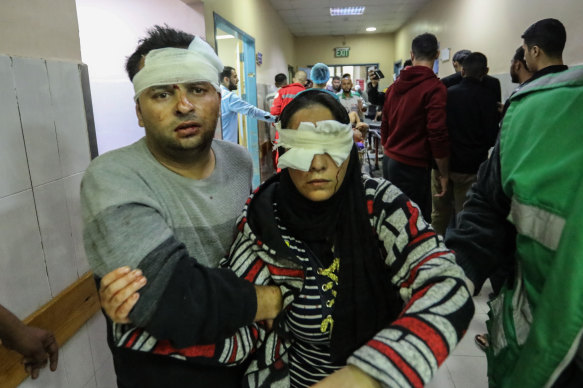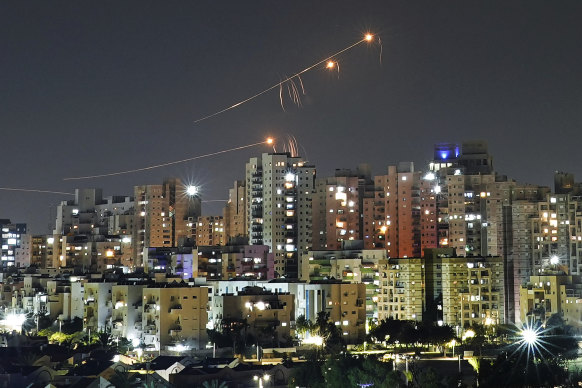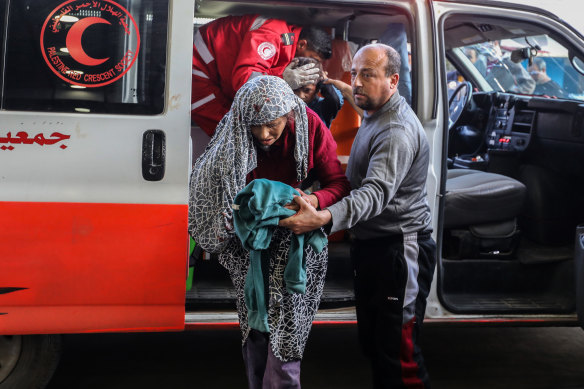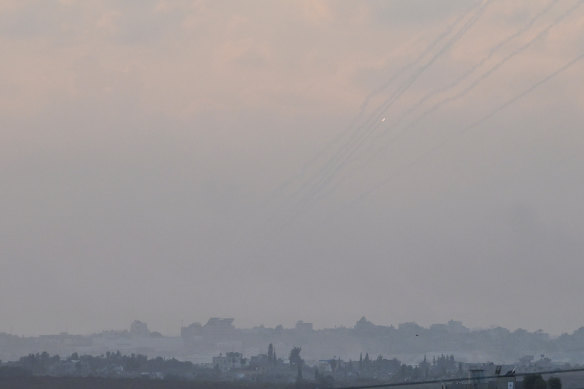This was published 1 year ago
Deaths in Gaza mount rapidly as Israeli planes strike
Israeli strikes on houses and buildings have killed at least 178 people throughout the Gaza Strip in the first hours of fighting after a weeklong truce collapsed Friday, according to the Health Ministry there.
Israel said it struck more than 200 Hamas targets. Militants in Gaza resumed firing rockets into Israel, and fighting broke out between Israel and Hezbollah militants operating along Israel’s northern border with Lebanon.

Palestinians injured in Israeli airstrikes arrive at Nasser Medical Hospital in Khan Younis, Gaza. Credit: Getty
Ceasefire mediator Qatar said efforts are ongoing to renew the truce, which saw Israel pause most military activity in Gaza and release 300 Palestinian prisoners in exchange for militants freeing over 100 hostages held in Gaza.
Weeks of Israeli bombardment and a ground campaign have left homeless more than three-quarters of Gaza’s 2.3 million residents, causing a humanitarian crisis as they face widespread shortages of food, water and other supplies. No trucks carrying aid entered Gaza from Egypt on Friday, Palestinians authorities said.
Up until the truce began, more than 13,300 Palestinians have been killed — roughly two-thirds of them women and minors — according to the Health Ministry in Hamas-ruled Gaza. The toll is likely much higher.

Israeli Iron Dome air defence system fires to intercept a rocket fired from the Gaza Strip, in Ashkelon.Credit: AP
Some 1200 Israelis were killed, mostly during Hamas’ October 7 attack on Israel that triggered the war.
Israeli airstrikes hit several points on the outskirts of Damascus early Saturday, Syrian state media reported.
State news agency SANA, citing an unnamed military official, said the strikes came from the direction of the Israeli-occupied Syrian Golan Heights and that Syrian air defences shot most of the missiles down. The strikes resulted in only “material losses,” the statement said.
The Syrian Observatory for Human Rights, a Britain-based opposition war monitor, said the strikes hit in the area of the south Damascus suburb of Sayyida Zeinab, where it said that “there are military forces working with the Lebanese Hezbollah.” It said ambulances rushed to the scene.
The UN said the fighting would worsen an extreme humanitarian emergency.
“Hell on Earth has returned to Gaza,” Jens Laerke, spokesperson for the UN humanitarian office in Geneva, said.
Defence Minister Yoav Gallant said he had been in one of Israel’s war jets during the assault to watch it up close. “The results are impressive. Hamas only understands force and therefore we will continue to act until we achieve the goals of the war,” he said.
Egyptian and regional sources told Reuters that Israel had informed several Arab states that it wants to carve out a buffer zone on the Palestinian side of Gaza’s border to prevent future attacks as part of proposals for the enclave after war ends.

Palestinians injured in Israeli airstrikes arrive at Nasser Medical Hospital in Khan Younis in the Gaza Strip on Friday.Credit: Getty Images
Medics and witnesses said Friday’s bombing was most intense in Khan Yunis and Rafah in the southern Gaza Strip, where hundreds of thousands of Gazans have been sheltering from fighting further north. Houses in central and northern areas were also hit.
“Anas, my son!” cried the mother of Anas Anwar al-Masri, a boy lying on a stretcher with a head injury in the corridor of Nasser hospital in Khan Younis. “I don’t have anyone but you!”
‘You have been warned’
Further south in Rafah, residents carried several small children, streaked with blood and covered in dust, out of a house that had been struck. Mohammed Abu-Elneen, whose father owns the house, said it was sheltering people displaced from elsewhere.
At the nearby Abu Yousef al-Najjar hospital, the first wave of wounded were men and boys.

Rockets are fired from Gaza into Israel on Friday.Credit: Getty Images
Gazans said they feared that the bombing of southern parts of the enclave could herald an expansion of the war into areas Israel had previously described as safe.
Leaflets dropped on eastern areas of the main southern city Khan Younis ordered residents of four towns to evacuate – not to other areas in Khan Younis as in the past, but further south to the crowded town of Rafah on the Egyptian border.
“You have to evacuate immediately and go to the shelters in the Rafah area. Khan Younis is a dangerous fighting zone. You have been warned,” said the leaflets, written in Arabic.
Israel released a link to a map showing Gaza divided into hundreds of districts, which it said would be used in future to communicate which areas were safe.
Each of the warring sides blamed the other for causing the collapse of the truce by rejecting terms to extend the daily release of hostages held by militants in exchange for Palestinian detainees.
The pause, which began on November 24, had been extended twice, and Israel had said it could continue as long as Hamas released 10 hostages each day. But after seven days during which women, children and foreign hostages were freed, Qatari and Egyptian mediators failed at the final hour to find a formula to release more, including Israeli soldiers and civilian men.
Israel accused Hamas of refusing to release all the women it held. A Palestinian official said the breakdown occurred over female Israeli soldiers.
Qatar said negotiations were still going on with Israel and Hamas to restore the truce, but that Israel’s renewed bombardment of Gaza had complicated its efforts.
US Secretary of State Antony Blinken, ending a trip to the region, said Hamas had started firing rockets before the pause in hostilities ended and had “reneged on commitments it made in terms of releasing certain hostages”.
He added he had met officials from Arab states and discussed how to create a “durable, lasting and secure peace”.
Israel has sworn to annihilate Hamas in response to the October 7 rampage by the militant group, when Israel says gunmen killed 1200 people and took 240 hostages.
Israel’s assault has laid waste to much of the Gaza Strip, which Hamas has ruled since 2007.
Palestinian health authorities deemed reliable by the United Nations say more than 15,000 Gazans have been confirmed killed and thousands more are missing and feared buried under rubble.
AP, Reuters
Get a note directly from our foreign correspondents on what’s making headlines around the world. Sign up for our weekly What in the World newsletter.